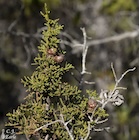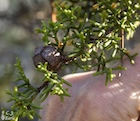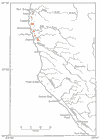Conservation Status

Hesperocyparis pygmaea
(Lemmon) Bartel (2009)
Common names
Mendocino or pigmy cypress (Peattie 1950).
Taxonomic notes
Synonymy: see POWO (accessed 2023.12.16). The spelling variants "pigmaea" and "pygmaea" appear in all names.
One molecular analysis has indicated that this taxon may be more closely related to Hesperocyparis macrocarpa than to H. goveniana (Terry et al. 2012), but the results thus far are inconclusive.
Description
Shrubs or small trees to 50 m tall and 200 cm dbh, or bearing cones at as little as 20 cm on shallow hardpan soils; crown pyramidal, dense or sparse, bearing a slender, whip-like leader. Bark smooth or rough, fibrous. Branchlets decussate, 1-1.5 mm diam. Leaves without abaxial gland or sometimes with embedded abaxial gland that does not produce drop of resin, not glaucous. Pollen cones 3-4 × 1.5-2 mm; pollen sacs 3-6. Seed cones globose, 1-2.5(-3) cm, grayish brown, not glaucous; scales 3-5 pairs, smooth, umbo nearly flat at maturity. Seeds 3-4(5) mm, dark brown to jet black, sometimes slightly glaucous" (Eckenwalder 1993, Wolf 1948).
Distribution and Ecology
USA: California: Mendocino County: two coastal area near Fort Bragg and Mendocino City. Habitat is the Mendocino White Plains, a highly acidic, nutrient-deprived white sandy soil over a hard clay. Some plants are dwarf, flowering when less than 1 m tall, and they occur with two pines (P. contorta and P. muricata) that flower at similarly diminutive sizes (Lanner 1999).
The IUCN treats this variety as an ecotype of H. goveniana, and does not give it a separate conservation evaluation; thus the two taxa taken together are "Endangered," and each considered alone is still more so.
Remarkable Specimens
The largest specimen has height 43 m, dbh 213 cm, crown spread 12 m, in Mendocino County, CA (American Forests 2000). A tree 48 meters (157 feet) tall was reported in 1929 (Lanner 1999).
Ethnobotany
No data as of 2023.12.16.
Observations
Based on historical collections and land preservation patterns, a good place to see the small trees would appear to be the Jackson State Forest, about two miles east of the city of Mendocino. HERE is a Google Maps image of a likely area.
Remarks
"The pygmy forests of this species and Pinus contorta on the shallow hardpan soils of coastal terraces of the Mendocino white plains are a remarkable example of phenotypic plasticity" (Eckenwalder 1993).
Citations
American Forests 2000. The National Register of Big Trees 2000. Washington, DC: American Forests.
Bartel 2009: described in Adams, R. P., J. A. Bartel and R. A. Price. 2009. A new genus, Hesperocyparis, for the cypresses of the western hemisphere. Phytologia 91(1):160-185.
Lemmon, J. G. 1895. West-American Cone-Bearers, 3rd ed. Pp. 76-77. http://www.cupressus.net/CUpygmaeaLemmon.html, courtesy of the Cupressus Conservation Project website.
Terry, R. G., J. A. Bartel, and R. P. Adams. 2012. Phylogenetic relationships among the New World cypresses (Hesperocyparis; Cupressaceae): evidence from noncoding chloroplast DNA sequences. Plant Systematics and Evolution DOI: 10.1007/s00606-012-0696-3.
See also
The species account at Threatened Conifers of the World.
Adams, R. P. and J. A. Bartel. Infraspecific variation in Hesperocyparis goveniana and H. pygmaea: ISSRs and terpenoid data. Phytologia 91(2):277-286.
Bisbee, Jeff. 2006. Photos at the Cupressus Conservation Project website.
Little (1970).
Sargent. 1901. North American trees. Botanical Gazette 31: 239-240. http://www.cupressus.net/CUpygmaeaSargent.html, courtesy of the Cupressus Conservation Project website.



